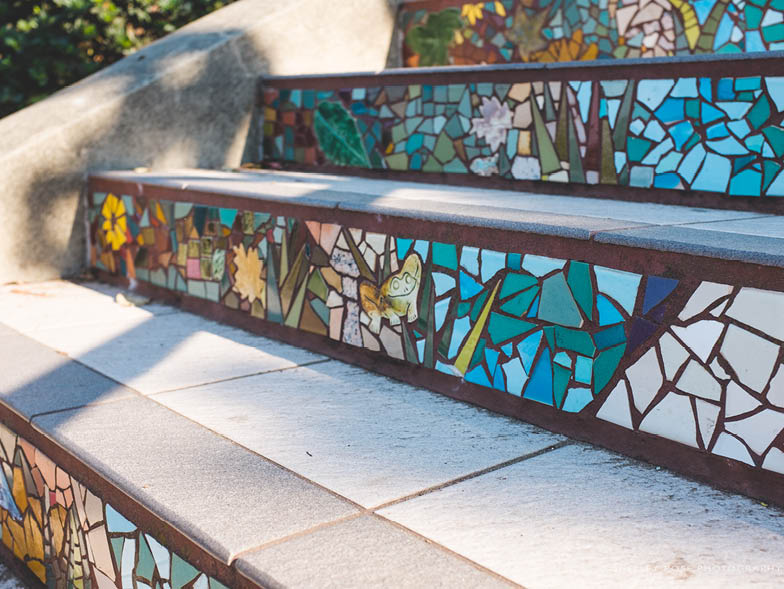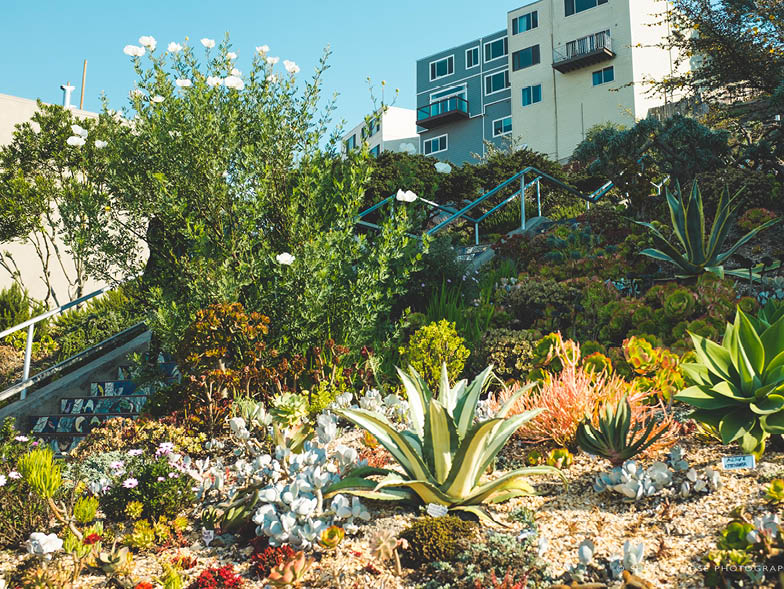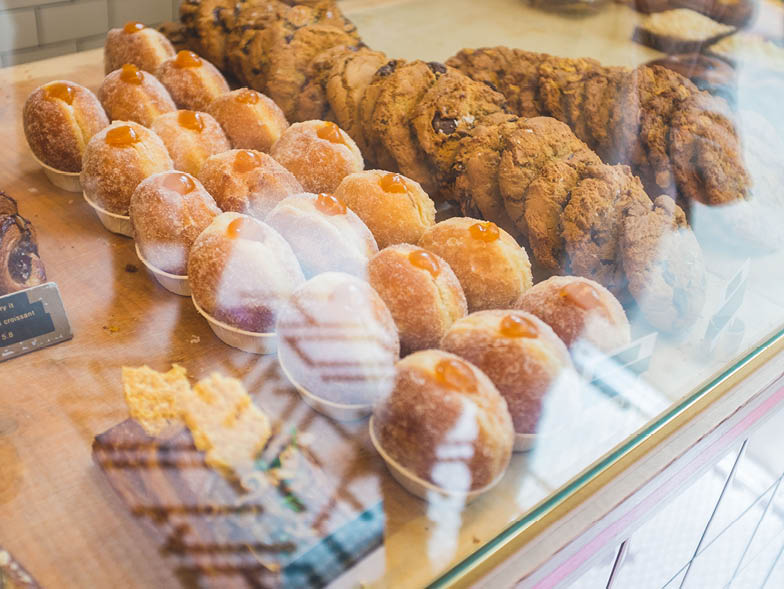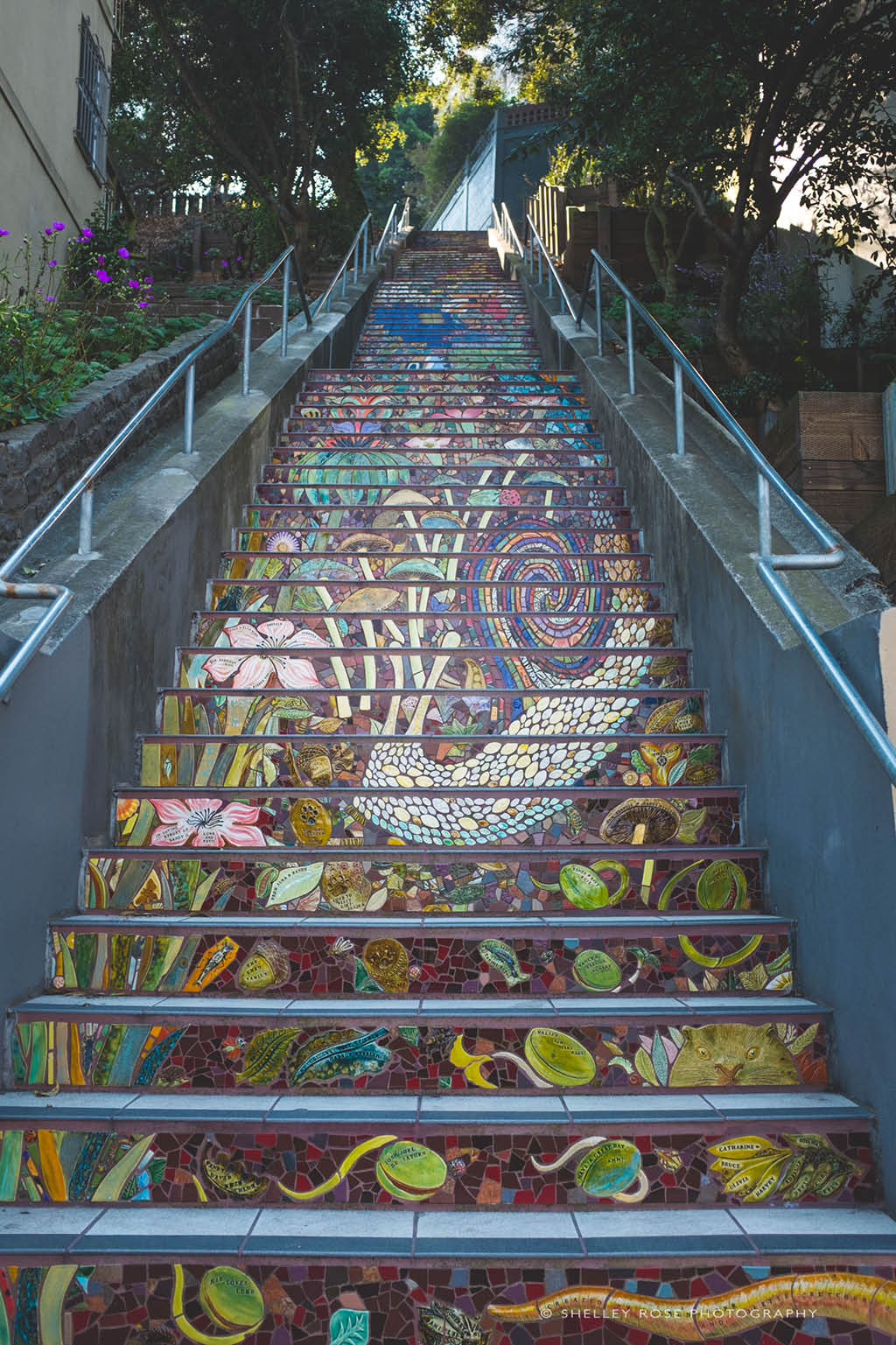Shades of San Francisco
If the climates of cities were people, San Francisco would be a fussy toddler flinging his winter coat to the floor, only to complain two minutes later that he’s cold as he wrestles to reintroduce his arm into the sleeve of his discarded jacket.
Thanks to a preemptive email from my tour guide, in which he had suggested, “Wear layers,” I was prepared to take on the three-hour urban hike of hidden staircases, my first adventure in the city. I imagine if you condensed the hike into a twenty-second aerial video, it would look like a flip- book featuring a tiny figure running up and down stairs while taking her coat off and on, and off and on.



Day One: Outdoor Adventures
Greg, our tour guide, is a Dublin native, with only 5 percent of his Irish accent still intact but 100 percent of his personality. A runner and former radio deejay, he had begun leading tours via Airbnb (“Hidden Stairways of SF Urban Hike”) as an interim job and ended up liking it so much, it’s now his primary job. Our little group met on Judah Street in front of St. Anne of the Sunset Catholic Church, a building reminiscent of a frosted birthday cake, built in the style of Romanesque revival, and painted the color of bubble gum. The part of town we were in was once called Outside Lands, and it’s built on sand, which was all that existed there back at the turn of the century. But after the 1906 earthquake and fire, people camped out here to escape burning, falling buildings. The city decided to use the space and created roads, and the neighborhood began to fill in.
We made our way to 15th Avenue, a magical street that becomes stairs at one point and then resumes being a street. (Cue the confused Uber drivers.) The staircase is quite long, and there was a collective sigh of relief when Greg said we would not be climbing it. Our first stop on the hidden staircase tour was the Hidden Garden Steps, one block over on 16th Avenue. They were built in the 1930s out of plain gray cement.
The neighborhood residents, inspired by another set of stairs called the 16th Avenue Tiled Steps, wanted to add beauty to their own community in a similar way. In 2011, they presented the idea to the city, who approved it under one condition: they had to pay for it themselves. Most of the names on the steps are people in the neighborhood who donated money toward the project.
Artists Aileen Barr and Colette Crutcher, who had previously designed the 16th Avenue Tiled Steps, were called in to spearhead the design. The completed mosaic, to which donors had contributed over $216,000, was installed in 2013. In addition to the art tiles, the hillside was planted with a variety of succulents, like the popular rosette-shaped aeoniums.
We soon arrived at the first set of stairs Aileen and Colette tackled, on Moraga Street. Greg laughed and explained,
“They are called the 16th Avenue Tiled Steps, though, because the people on 16th Avenue paid for them, and the people on Moraga did not.” Alice Yee Xavier and her friend Jessie Audette had a vision for the steps in their neighborhood. Jessie had lived in Rio de Janeiro, where painted stairs are plentiful, and they were inspired to bring the same vibrancy to their corner of the world. The stairs feature a sun at the top, then a moon, a stream, a river that runs through a forest, and, finally, the ocean. On one particular step, you’ll find a tea kettle tile with Alice and Jessie’s names on it and two tea cups with Aileen and Colette’s names.
Alice Yee Xavier also lives next door and tends the hillside garden. She took the time to label the names of each plant, and once in a while you might also find a sign with a photo of someone stealing a flower or plant. Vigilante justice can be quite creative.

If you hang a right at the top of the 16th Avenue Tiled Steps, you’ll eventually encounter Noriega Street and the entrance to the zigzagged wooden staircase that leads to Grandview Park. The amount of wind at the top is shocking, but it’s worth it for the panoramic splendor, including a view of Golden Gate Park.
This behemoth of a park was the dream of Scotland-born John McLaren, who wanted a park on the West Coast that would rival Central Park. (It’s actually 20 percent bigger!) He managed to create an evergreen expanse, despite the existing landscape of sand dunes. He loved trees but hated statues, and if he could not win the battle against one, he was known to rearrange the park to hide it as much as possible by planting trees or other greenery.
From this high up, it’s easy to see how compact San Francisco really is. At about seven miles by seven miles, it holds more than 850,000 residents in comparison to the Bay Area’s whopping 7.5 million.
The tour wound down and through the Forest Hill neighborhood where Willie Mays, one of the greatest baseball players ever, lived for a short while in a home on Mendosa Avenue. The tour concluded near a pizza shop, thankfully, because I was ready to eat a street sign somewhere around the three-hour mark. Note to self: eat breakfast. Greg’s accent may have faded, but his Irish hospitality and friendliness shone in every interaction he had with his neighbors, who were surprisingly pleased to have visitors traipsing through and admiring their staircases and gardens.
After inhaling a pizza, I stopped into the Game Parlour, an open and airy game cafe that was packed with people set up at long tables. I snuck onto the end of a table to munch on a sweet gluten-free waffle with strawberries and coconut whipped cream and listened to the soundtrack of happy people in competition mode.
It was nearing sunset, and I knew the Sutro Baths would be a prime viewing spot. Though signs declare the ruins are dangerous, people were walking all over them like a jungle gym. A bride teetered on high heels as she crossed a concrete beam with her groom, as their photographer followed closely behind. The Sutro Baths were once a privately owned public saltwater swimming pool complex in the Lands End area of San Francisco. They were built in 1896 by Adolph Sutro, a wealthy entrepreneur who also owned the nearby Cliff House. I tried to imagine it in its heyday as the sky stratified into peach, rose, and lilac layers.


Day Two: Indoor Adventures
A hearty brunch was my first priority, given my appetite misjudgment of day one. Little Gem, a sweet, order-at-the-counter brunch place, is great for people with food allergies. I indulged in almond-and-quinoa-flour pancakes with vanilla coconut cream. My brunch mate had the simple scramble with eggs and greens.
We parted ways, and I went in search of the Golden Gate Fortune Cookie Factory, an aptly named hidden gem, as its entrance is tucked away in Ross Alley in bustling Chinatown. Letting my nose navigate, I followed the humid and sugar-laced scent of baked dough to a doorway where Kevin Chan welcomed me with a platter of flat, circular cookies. This shoebox-sized factory has existed in the same location since its inception in 1962. The original owner, Franklin Yee, passed away in 2015, and it’s now owned by Nancy Chan. Her son, Kevin, came on board to help transform it from a cookie factory to a retail shop, tourist attraction, and historic landmark.
Two of the three cookie-making machines are antiques from the 1950s with just one speed, which means the three employees have four seconds to fold the cookie before it hardens and ends up in the free customer samples bin. The golden batter, made of sesame seeds, butter, eggs, flour, and sugar, is pumped onto little griddles, which reappear four and a half minutes later, hot and soft, ready to be folded around a tiny paper fortune by deft fingers that have the motion down in muscle memory. Kevin urged me to write my own fortunes for a friend, and I asked what his favorite is. “Be who you are,” he answered me. It’s not an easy business and the hours are long, but Kevin feels rewarded by the knowledge he is helping the city and his community. I wanted to know if he will stay in the business, and he pointed to a quote painted on the wall: “Happiness is serving.”
I felt a part of something special as I sat at the small desk tucked against a wall, watching a process that’s long been automated in other factories.

I’m grateful to Kevin and Nancy for preserving this bit of San Francisco history and sharing it with others. His generosity was touching as he loaded up a cloth bag with the personalized fortune cookies plus another container of chocolate-dipped cookies. I think of what I wrote in one of them, “Love folded up into a crispy cookie,” and it’s evident both Nancy and Kevin have poured their love into this doughy legacy.
It seemed logical to continue my pursuit of sweet things, so I reserved a time slot for my friend and me to tour the Museum of Ice Cream, a quasi-art installation and elaborate ice cream tasting that I sensed was primarily for selfies and Instagram. When the tour guide, whose job title seemed to be “hype master,” jokingly chided us for not responding enthusiastically enough, I wanted to yell back, “Where is the tour for 37-year-olds who do not like audience participation?” But I persevered and dutifully waited in line to swim in the sprinkle pool, which I will admit was a very pleasing sensory experience. There were ice cream tastings along the way, as well as mochi and paletas—I chose pineapple! Sure, at $38, it was a bit pricey, but I now have a hilarious photo of my friend hugging a pink wall full of whipped cream cans.
San Francisco’s changing climate does not only refer to the weather—it’s an apt metaphor for this city, in that people can find whatever experience they seek, whether it be a three-hour hike with an affable former Dubliner, a glimpse into the history and soul of an iconic cookie shop, or indulging your inner teenager by posing with giant gummy bears and naming yourself after ice cream flavors. On that note, this is Rainbow Sherbet Shelley signing off from the Golden City, California.
For more info, visit goldengatefortunecookies.com, museumoficecream.com, hiddengardensteps.org, and 16thavenuetiledsteps.com






















